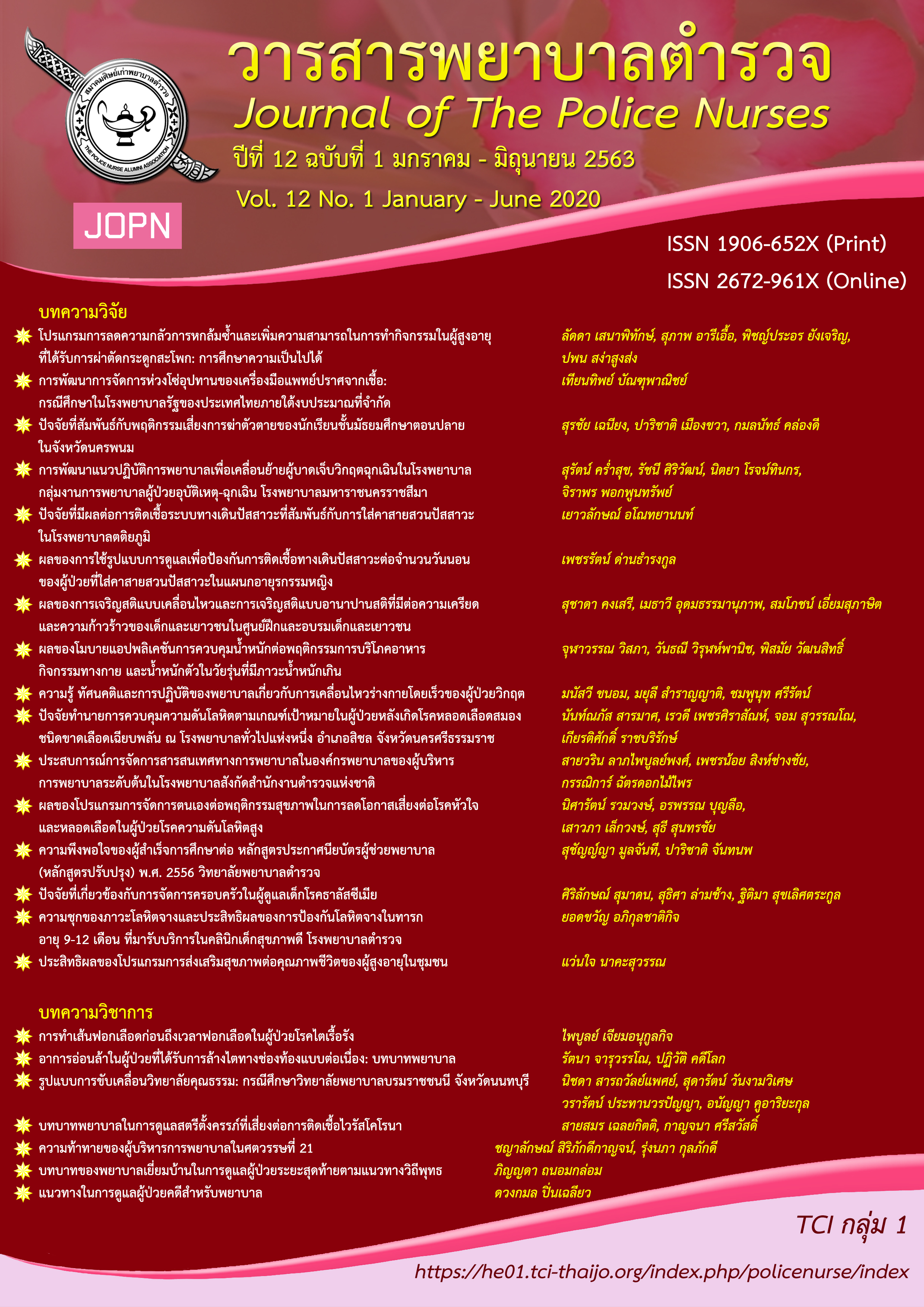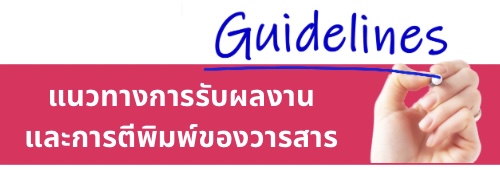ความรู้ ทัศนคติและการปฏิบัติของพยาบาลเกี่ยวกับการเคลื่อนไหวร่างกายโดยเร็วของผู้ป่วยวิกฤต
คำสำคัญ:
ความรู้, ทัศนคติ, การปฏิบัติ, การเคลื่อนไหวร่างกายโดยเร็ว, ผู้ป่วยวิกฤตบทคัดย่อ
การวิจัยเชิงพรรณนานี้มีวัตถุประสงค์เพื่อศึกษาระดับความรู้ ทัศนคติและการปฏิบัติของพยาบาลเกี่ยวกับการเคลื่อนไหวร่างกายโดยเร็วของผู้ป่วยวิกฤต และหาความสัมพันธ์ระหว่างการได้รับการฝึกอบรมเกี่ยวกับการเคลื่อนไหวร่างกายโดยเร็ว และประสบการณ์การทำงานในหอผู้ป่วยหนักกับการปฏิบัติของพยาบาลเกี่ยวกับการเคลื่อนไหวร่างกายโดยเร็วของผู้ป่วยวิกฤต ตัวอย่าง คือ พยาบาลวิชาชีพจำนวน 125 คน ที่ปฏิบัติงานในหอผู้ป่วยหนักหรือหอผู้ป่วยวิกฤตในแผนกผู้ป่วยวิกฤตอายุรกรรมและแผนกผู้ป่วยวิกฤตศัลยกรรม คัดเลือกตัวอย่างตามเกณฑ์คุณสมบัติที่กำหนด คือ มีประสบการณ์การทำงานในหอผู้ป่วยหนักหรือหอผู้ป่วยวิกฤตอย่างน้อย 3 เดือน และยินดีเข้าร่วมงานวิจัย รวบรวมข้อมูลโดยใช้ แบบสอบถามข้อมูลส่วนบุคคล และแบบสำรวจทัศนคติและความเชื่อในการเคลื่อนไหวร่างกายผู้ป่วยสำหรับหอผู้ป่วยหนัก (Patient Mobilization Attitudes and Beliefs Survey for the Intensive Care Unit: PMABS-ICU) ฉบับแปลเป็นภาษาไทยโดยผู้วิจัย ผ่านการตรวจสอบความตรงตามเนื้อหาเชิงวัฒนธรรมด้วยวิธีการแปลย้อนกลับ และผ่านการทดสอบความเชื่อมั่นได้ค่าสัมประสิทธิ์แอลฟาของครอนบาคเท่ากับ .88 หลังจากรวบรวมข้อมูลผู้วิจัยได้รับแบบสอบถามที่สมบูรณ์คืน 121 ฉบับ คิดเป็นอัตราตอบกลับร้อยละ 96.80 วิเคราะห์ข้อมูลโดยใช้สถิติเชิงพรรณนา วิเคราะห์ความสัมพันธ์ระหว่างตัวแปรโดยใช้สัมประสิทธิ์สหสัมพันธ์แบบพอยท์ไบซีเรียล และสัมประสิทธิ์สหสัมพันธ์ของสเปียร์แมน
ผลการวิจัยพบว่า 1) พยาบาลมีค่าเฉลี่ยคะแนนความรู้อยู่ในระดับมาก (M = 14.39 คะแนน, SD = 2.62) จากคะแนนเต็ม 20 คะแนน คิดเป็นร้อยละ 71.95 ขณะที่มีค่าเฉลี่ยคะแนนทัศนคติอยู่ในระดับปานกลาง (M = 29.48 คะแนน, SD = 2.62) จากคะแนนเต็ม 45 คะแนน คิดเป็นร้อยละ 65.51 และมีค่าเฉลี่ยคะแนนการปฏิบัติอยู่ในระดับปานกลาง (M = 40.43 คะแนน, SD = 7.31) จากคะแนนเต็ม 65 คะแนน คิดเป็นร้อยละ 62.20 2) การได้รับการฝึกอบรมเกี่ยวกับการเคลื่อนไหวร่างกายโดยเร็วมีความสัมพันธ์ทางบวกกับการปฏิบัติของพยาบาลเกี่ยวกับการเคลื่อนไหวร่างกายโดยเร็วของผู้ป่วยวิกฤตอย่างมีนัยสำคัญทางสถิติ (r = .26, p = .004) ส่วนประสบการณ์การทำงานในหอผู้ป่วยหนักไม่มีความสัมพันธ์ทางสถิติกับการปฏิบัติของพยาบาลเกี่ยวกับการเคลื่อนไหวร่างกายโดยเร็วของผู้ป่วยวิกฤต
Downloads
เอกสารอ้างอิง
Adler, J., & Malone, D. (2012). Early mobilization in the intensive care unit: A systematic review. Cardiopulmonary Physical Therapy Journal, 23(1), 5-13.
Akinremi, A., Sanusi, A., Osinaike, B., Ogwu, S., & Arinola, S. (2016). 1162: Clinicians’ knowledge, attitude, and practice of active mobilization in resource-limited hospitals. Critical Care Medicine, 44(12), 366. doi:10.1097/01.ccm.0000509837.99795.7d
Appleton, R. T., Kinsella, J., & Quasim, T. (2015). The incidence of intensive care unit-acquired weakness syndromes: A systematic review. Journal of the Intensive Care Society, 16(2), 126-136. doi:10.1177/1751143714563016
Autthamana, S. (2002). Organizational behavior: Theory and application (3rd ed.). Bangkok: Thammasat University.
Asfour, H. I. (2016). Contributing factors for acquired muscle weakness in intensive care unit. Journal of Nursing Education and Practice, 6(8), 102-111. doi:10.5430/jnep.v6n8p102
Barber, E. A., Everard, T., Holland, A. E., Tipping, C., Bradley, S. J., & Hodgson, C. L. (2015). Barriers and facilitators to early mobilization in intensive care: a qualitative study. Australian Critical Care, 28(4), 177-182. doi:10.1016/j.aucc.2014.11.001
Cabana, M. D., Rand, C. S., Powe, N. R., Wu, A. W., Wilson, M. H., Abboud, P. A. C., & Rubin, H. R. (1999). Why don't physicians follow clinical practice guidelines?: A framework for improvement. The Journal of the American Medical Association, 282(15), 1458-1465. doi:10.1001/jama.282.15.1458
California Pacific Medical Center [CPMC]. (2005). What is the ICU (intensive care unit)? Retrieved from http://www.cpmc.org/learning/documents/icu-ws.pdf
Chaiwong, W., Phetsuk, N., Liwsrisakun, C., & Pothirat, C. (2019). Short-term impact of mobilization of patients who are being mechanically ventilated in the medical intensive care unit. Journal of the Medical Association of Thailand, 102(2), 171-177.
Dubb, R., Nydahl, P., Hermes, C., Schwabbauer, N., Toonstra, A., Parker, A. M., . . . Needham, D. M. (2016). Barriers and strategies for early mobilization of patients in intensive care units. Annals of the American Thoracic Society, 13(5), 724-730. doi:10.1513/AnnalsATS.201509586CME
Fontela, P. C., Forgiarini Jr, L. A., & Friedman, G. (2018). Clinical attitudes and perceived barriers to early mobilization of critically ill patients in adult intensive care units. Revista Brasileira de Terapia Intensiva, 30(2), 187-194. doi:10.5935/0103-507X.20180037
Goodson, C. M., Friedman, L. A., Mantheiy, E., Heckle, K., Lavezza, A., Toonstra, A., . . . & Outten, C. (2018). Perceived barriers to mobility in a medical ICU: The patient mobilization attitudes & beliefs survey for the ICU. Journal of Intensive Care Medicine. doi:10.1177/0885066618807120.
Grimm, J., Silvestri-Elmore, A., Grimm, E., Klinger, K., Nye, S., & Bhullar, J. (2019). Perceived barriers to early progressive mobilization in the ICU: Multidisciplinary perspectives in an underserved population. Journal of Nursing Education and Practice, 9(5), 102-109.
Hermans, G., & Van den Berghe, G. (2015). Clinical review: Intensive care unit acquired weakness. Critical Care, 19(274). doi:10.1186/s13054-015-0993-7
Hodgson, C. L., Berney, S., Harrold, M., Saxena, M., & Bellomo, R. (2013). Clinical review: early patient mobilization in the ICU. Critical Care, 17(1), 207. doi:10.1186/cc11820
Jantaraprapa, J. (2015). Body of knowledge – knowledge – knowledge management (km). Retrieved from http://www.royin.go.th/?knowledges=body-of-knowledge-knowledge-knowledge-management-km
Johnson, K., Petti, J., Olson, A., & Custer, T. (2017). Identifying barriers to early mobilisation among mechanically ventilated patients in a trauma intensive care unit. Intensive and Critical Care Nursing, 42, 51-54. doi:10.1016/j.iccn.2017.06.005
Jolley, S. E., Regan-Baggs, J., Dickson, R. P., & Hough, C. L. (2014). Medical intensive care unit clinician attitudes and perceived barriers towards early mobilization of critically ill patients: A cross-sectional survey study. BMC Anesthesiology, 14(84). doi:10.1186/1471-2253-14-84
Laurent, H., Aubreton, S., Richard, R., Gorce, Y., Caron, E., Vallat, A., . . . Coudeyre, E. (2016). Systematic review of early exercise in intensive care: A qualitative approach. Anaesthesia Critical Care & Pain Medicine, 35(2), 133-149. doi:10.1016/j.accpm.2015.06.014
Leong, Y., Rasnah, A., Chong, M. (2017). Patient early mobilization: A Malaysia’s study of nursing practices. Journal of Intensive and Critical Care, 3(3), 29. doi:10.21767/2471-8505.100088
Lin, F., Phelan, S., Chaboyer, W., & Mitchell, M. (2019). Early mobilisation of ventilated patients in the intensive care unit: A survey of critical care clinicians in an Australian tertiary hospital. Australian Critical Care, 33(2), 130-136. doi:10.1016/j.aucc.2019.02.002
Messer, A., Comer, L., & Forst, S. (2015). Implementation of a progressive mobilization program in a medical-surgical intensive care unit. Critical Care Nurse, 35(5), 28-42. doi:10.4037/ccn2015469
Mullins, P. M., Goyal, M., & Pines, J. M. (2013). National growth in intensive care unit admissions from emergency departments in the United States from 2002 to 2009. Academic Emergency Medicine, 20(5), 479-486. doi:10.1111/acem.12134
National Institute for Emergency Medicine (NIEM). (2019). Emergency medical criteria: Continuous monitoring report. Retrieved from https://ws.niems.go.th/KPI57/2557/kpireportcontinue01.aspx
Nittayanggoon, S. (2008). Standard for critical care nursing. In Jirasinthipok, T., Jermviwatkul, P., Nittayanggoon, S., Wongsuvansiri, S., & Wongjareun, S. (Eds.), Standard of care in hospitals (pp. 187-219) (2nd ed.). Nonthaburi: The War Veterans Organization of Thailand.
Parry, S. M., Remedios, L., Denehy, L., Knight, L. D., Beach, L., Rollinson, T. C., . . . & Granger, C. L. (2017). What factors affect implementation of early rehabilitation into intensive care unit practice? A qualitative study with clinicians. Journal of Critical Care, 38, 137-143. doi:10.1016/j.jcrc.2016.11.005
Phasook, K., & Ua-Kit. N. (2015). The effect of early mobilization program on duration of mechanical ventilation in critically ill medical patients. Thai Journal of Cardio-Thoracic Nursing, 26(1), 57-72.
Prasanth S., Rajani, V., & Mathai, A. K. (2013). Common mistake in adjusting sample size for anticipated dropout in clinical trial. Retrieved from https://pdfs.semanticscholar.org/d7df/a6cb72872238df33fd9249b4a103a17489a8.pdf
Prousoontron, M., & Oumtanee, A. (2008). Working as a membership of professional nurses. Journal of Nursing Science Naresuan University, 2(2), 15-23.
Rawal, G., Yadav, S., & Kumar, R. (2017). Post-intensive care syndrome: An overview. Journal of Translational Internal Medicine, 5(2), 90-92. doi:10.1515/jtim-2016-0016
Sanusi, A. A., Osinaike, B., Ogwu, S., Sanya, A., & Akinremi, A. A. (2015). Knowledge, attitude and practices of care-providers about early mobilization in the ICU-report from a Nigerian Hospital. American Journal of Respiratory and Critical Care Medicine, 191, A2276.
Sawasdipanich, N., Tiansawad, S. (2011). Research instrument translation for cross-cultural research: techniques and characteristics that need to be considered. Thai Journal of Nursing Council, 26(1), 19-28.
Schwartz, N. E. (1975). Nutritional knowledge, attitudes, and practices of high school graduates. Journal of the American Dietetic Association, 66(1), 28-31.
Smithikrai, C., (2012). Personnel training in organization (Revised version). Chiang Mai: Faculty of Humanities, Chiang Mai University.
Society of Critical Care Medicine [SCCM]. (2018). Critical care statistics. Retrieved from http://www.sccm.org/Communications/Critical-Care-Statistics
Sutamma, P., & Teeranut, A. (2018). Effects of an evidence-based nursing model on mobilization promoting of critically ill patients: Pilot study. Journal of Nursing Science & Health, 41(1), 56-63.
Sutthilertarun, S. (2000). Human behavior and development. Bangkok: Aksarapipat.
Taweerat., P. (2000). Research method in behavior science and social science (7th ed.). Bangkok: Srinakharinwirot University.
Thorndike, R. M. (1978). Correlational Procedures for Research. New York, NY: Gardner Press.
Vollman, K. M. (2010). Introduction to progressive mobility. Critical Care Nurse, 30(2), S3-S5.
Winkelman, C., & Peereboom, K. (2010). Staff-perceived barriers and facilitators. Critical Care Nurse, 30(2), S13-S16. doi:10.4037/ccn2010393
Zhu, Y. P., Xia, L. X., & Li, G. H. (2018). Management of early mobilization in intensive care units: A multicenter cross-sectional study. Frontiers of Nursing, 5(4), 291-299. doi:10.1515/fon-2018-0043
ดาวน์โหลด
เผยแพร่แล้ว
รูปแบบการอ้างอิง
ฉบับ
ประเภทบทความ
สัญญาอนุญาต
ผลงานที่ได้ตีพิมพ์แล้วจะเป็นลิขสิทธิ์ของวารสารพยาบาลตำรวจ















